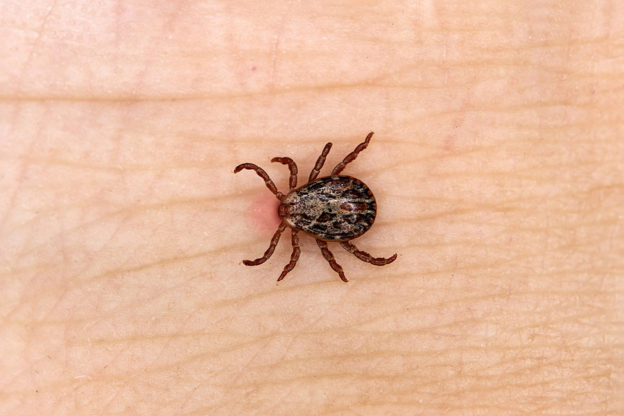By David Blyweiss, M.D., Advanced Natural Wellness
March 17, 2021
Between a year of on-again/off-again lockdowns and a particularly brutal winter, I’ll bet you’re chomping at the bit to get outside again.
Now that the weather’s warming up, you finally have the chance.
But before you hit your local hiking trails or head to a forested area for camping, fishing or backpacking, take note…
Wooded areas and forests are a breeding ground for ticks.
I know. You’re laughing pretty hard right now. Out of all of the risks found in the wild – snakes, bears, scorpions and other species – I’m talking about ticks.
Open your arteries, improve blood flow for a new health miracle...
Did you know your circulatory system has over 60,000 miles of arteries, veins and other blood vessels, if stretched end to end?
But as you age, your blood vessels undergo changes, which may cause them to stiffen, thicken and get clogged.
GOOD NEWS! Doctors have now identified a “Miracle Molecule” inside your arteries that helps OPEN your arteries and IMPROVE blood flow.
It’s what Dr. Valentin Fuster calls it, "One of the most important discoveries in the history of cardiovascular medicine."To you, that means...
- Healthy blood pressure
- Sharper mind and memory
- Skyrocketing energy and muscular strength
- Increased pleasure and passion in the bedroom
- Improved circulation to every cell and organ in your body
Go here to discover a new natural way to significantly boost the levels of this miracle molecule in YOUR body NOW!
More specifically, I’m talking about Lyme disease. And it’s no laughing matter.
Lyme disease was identified in 1981 in Lyme, Connecticut after first showing up in dozens of children and adults in 1975. These days, the CDC estimates that as many as 476,000 people get it each year.
Nature’s Dirty Hypodermic Needles
Just think of ticks as nature’s dirty hypodermic needles. Whether they are found on deer, dogs, rats or other animals, these parasites pick up all kinds of crap. One of the most common passengers on the tick is Lyme disease’s Borrelia burgdorferi.
Other common passengers on the tick are Ehrlichia, Bartonella, Rickettsia and Babesia bacterias. All act as co-infections, and Lyme patients with these co-infections generally suffer more severe illness and a much longer recovery.
Are You Suffering From...
- Love handles and a pot belly
- Romance that isn't what it used to
- Forgetfulness and inattention
- Low (or no) strength and endurance
- A sex drive that's shifted into neutral...or worse
If so...you may have Mature Male Burnout. Click here to discover more about this unique condition and what you can do about it.
So unless you see the rash or the tick that caused the rash – and start antibiotics immediately for two or three weeks – you’re sort of lost.
It will hide in the body, including in your lymph nodes. Once there, it’s going to go through life stage switching to avoid detection and destruction.
You’ve got the initial long, Gram-negative spirochete bacteria, then a dormant cyst, then the active reproducing bacterial stage. Depending on what stage it’s in, an antibiotic like doxycycline or amoxicillin may or may not kill it.
Worse, you can end up with so many symptoms that it’s hard to diagnose. There’s pain, fatigue, rash, joint pain, memory loss. You just want to die. You can’t move. You can’t work. And just think! People used to think those afflicted were faking it.
Now we know better.
We also know that If Lyme isn’t caught early and immediately treated with antibiotics, there are still options available.
The current integrative line of thinking is to use combination treatments. And it’s not just with antibiotics.
Herbs proven to kill the bacteria are also used, as well as ozone therapy and bioactive silver hydrosol. But it takes a while to work and the treatments are so intense that it can be a little rough. Plus, it can be a relatively expensive process.
Still, it’s amazing how far we’ve come when it comes to treating Lyme disease.
Protect Yourself against Tick-Borne Illnesses
You have to be careful. If you’re not a natural hiker or outdoorsman, don’t go into the woods. If you get bitten, don’t try to pull the tick out with forceps. Go to the doc and begin your antibiotics right away.
If you thrive on outdoor activity and enjoy being in nature, make sure to take precautions.
- Wear light-colored clothing so you can easily spot any ticks crawling on you.
- Choose long-sleeved shirts, long pants and boots when you hike. Tuck your pants into the top of your boots or your socks.
- Apply a tick repellent ahead of time. I recommend something natural, like nootka tree oil (nootkatone) which is found in Alaskan yellow cedars and grapefruit. It’s a naturally occurring compound that repels ticks and other insects.
- Stay on trails whenever possible. These are generally free of brush and weeds that could deposit a tick on you.
- Periodically give you and your companions a quick tick check. The tick has to be attached for a while before Lyme disease’s Borrelia burgdorferi can be transmitted to you. So finding and removing ticks quickly and safely can save you a lot of worry later.
- Cleanse the area around the tick with rubbing alcohol; using pointy headed tweezers get right down to the skin where the tick is and pinch as near to the head as possible. Pull straight up steadily and slowly, removing the tick. Cleanse the area again with alcohol. Now you’re good to go, and remember… stay on the path, no short cuts through the woods.
SOURCES:
Krause PJ, et al. Concurrent Lyme Disease and Babesiosis: Evidence for Increased Severity and Duration of Illness. JAMA. 1996;275(21):1657–1660.
Rowen RJ. Ozone therapy as a primary and sole treatment for acute bacterial infection: case report. Med Gas Res. 2018;8(3):121-124.
Sapi et al. Characterization of biofilm formation by Borrelia burgdorferi in vitro. PLOS One. 2012;7(10):e48277.
Lambadi PR, et al. Facile biofunctionalization of silver nanoparticles for enhanced antibacterial properties, endotoxin removal, and biofilm control. Int J Nanomedicine. 2015; 10: 2155–2171.






